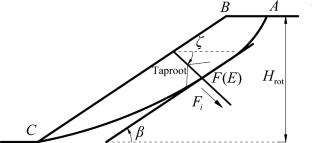Seismic stability analysis of shallow overburden slopes with vegetation protection
Abstract
Vegetation is an effective and environmental-friendly approach to improve slope stability. However, due to the lack of reasonable calculation methods for vegetated slopes, the analysis theory of ecological slope protection lags behind the engineering application. Based on the shallow translational failure model considering the boundary effects, the dimensionless seismic stability number of shallow overburden slopes with or without vegetation protection was deduced by using the upper limit method of limit analysis. A series of stability charts for slopes with or without vegetation protection under seismic excitations with different amplitudes were provided. The results show that the underestimation degree of the safety factor calculated from the infinite slope model increases gradually with the increase of the thickness ratio of the shallow overburden. Compared with the slope without vegetation protection, the seismic stability number of the slope with vegetation protection is nonlinear. The proposed stability charts show good performance for rapidly obtaining the safety factor with calculation errors of less than 9%, which is useful in assessing the safety of the shallow overburden slopes with vegetation protection in the preliminary design.



 求助内容:
求助内容: 应助结果提醒方式:
应助结果提醒方式:


